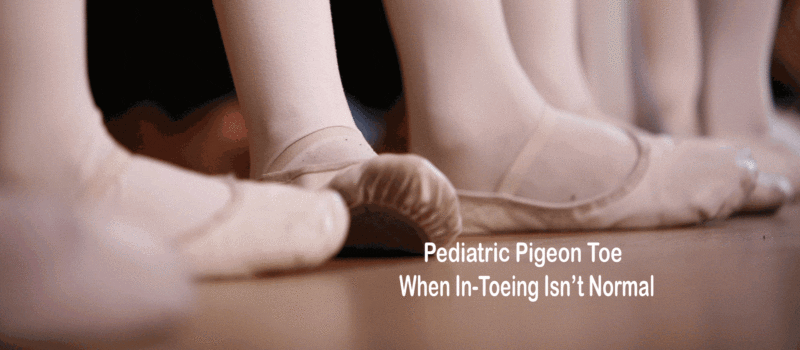
Pigeon Toed – In-Toeing in the Pediatric Population
It is common and is often normal.
It is the motor milestone that is most highly anticipated when your child reaches the age of one. As your little one progresses from a crawl to a wobbly first few steps, it is common for parents to become fixated on their child’s new found skill.
Learning to walk takes a lot of practice and it is very common for parents to notice their kids toes turning in. It can make you feel a bit uneasy seeing your child walking with their toes turned but it is very common – generally in-toeing does not create any pain and will correct on its own by the age of 7 or 8. Furthering parents concerns is that in-toeing can appear to be worse when the child is fatigued or sick. This is not to say that in-toeing should be disregarded or ignored.
There are times when a more detailed assessment may be necessary.
Parents should pay particular attention when a child demonstrates:
- Limping
- Knee and Foot Pain
- In-toeing found only on one side
- Functional Limitations with activities of daily living or sports
- Abnormal Walking/Running Patterns
- Motor Milestone Delays
- Persistent In-toeing after the age of 8
- Family History of Rickets, Skeletal Dysplasia, Metabolic Disorders
Why does my child walk with their toes pointed in?
Occasionally, in-toeing can be due to structural limitations and most medical professionals believe that these bony changes are due to the child’s position during pregnancy. The leg bones sometimes have to rotate while they lengthen inside the uterus due to the space constraints. It is common for the leg bones to keep rotating for the first couple years after birth, but the rotational difference is first noticed when the child begins to walk.
The most common reason for In-toeing in toddlers…
Most commonly in-toeing is due to Tibial Rotation. This is when the shin bone rotates to the midline and it is usually seen in toddlers (1-3 year of age). Tibial rotation is common to be found in both shins which means that both of the child’s feet will be in-toeing.
Another bone that can rotate during pregnancy is the child’s femur and the medical term is called femoral anteversion. It is when the femoral neck is positioned anterior relative to the shaft of the femur. When the femur is rotated in this manner, the child compensates by turning their leg inwards creating an intoeing walk. Similar to Tibial Rotation, it is usually found in both legs but is usually in early childhood (3-6 year of age). Femoral Anteversion can be a trait passed to children by their parents and is more likely to be seen in boys than girls.
The last structural change that may lead to Intoeing deals specifically with the foot. Sometimes the forefoot can turn in causing the lateral border of the foot to become curved. In more severe cases, the inside of the foot can present with a crease. It has been found to occur in approximately 1 in every 1,000 births and has the same occurrence in both males and females.
Our pediatric program is here for children with in-toeing and much more:
Physical therapists can use specific assessment measures to rule in or out any structural changes that may have occurred. Finding out if structural changes have occurred can help guide treatment or allow a proper referral to an orthopedic doctor. If no structural limitations are found on assessment, in-toeing can be caused by restrictions to hip range of motion, hip weakness, flat feet, balance problems, or even habitual movement patterns. Historically, healthcare providers have recommended bracing or alternative footwear to help treat in-toeing; however, treatment has now branched to monitoring progression and hip strengthening as the most effective strategies. Our experts in Pediatric Rehabilitation are specially trained to identify the causes and develop a treatment program.
We are here for your kids. Get in touch with us to schedule a discovery assessment with our pediatric team.
Special thanks to Jason Waddell for his contribution to this article.
As always, In health – Grant
